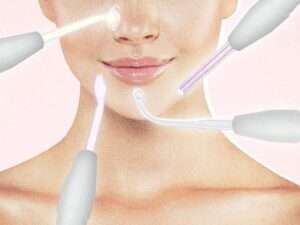High Frequency

High-frequency treatment in cosmetics involves the use of a high-frequency device that produces a mild electrical current to address various skin concerns. This non-invasive and safe procedure is often performed in professional skincare settings. Here’s a detailed overview of high-frequency treatment in cosmetics:
High-Frequency Device:
1. Electrode Attachment:
– The high-frequency device typically consists of a handheld wand with a glass electrode attachment. The electrode may come in different shapes and sizes, allowing for versatility in treating various areas of the face and body.
2. Current Generation:
– The device generates a high-frequency alternating current, usually in the range of 100,000 to 250,000 Hertz (cycles per second). The current is applied to the skin through the glass electrode.
3. Ozone Production:
– When the high-frequency current passes through the inert gas within the electrode (often argon or neon), it produces a low-level electrical current and ozone. The creation of ozone gives the treatment its distinct glow.
High-Frequency Treatment Benefits:
1. Acne Treatment:
– High-frequency treatment is commonly used to target acne-prone skin. The high-frequency current has antimicrobial properties, helping to kill acne-causing bacteria. It also reduces inflammation and promotes faster healing of acne lesions.
2. Improving Blood Circulation:
– The gentle massage effect of high-frequency treatment can enhance blood circulation. Improved blood flow to the skin contributes to a healthier complexion and may promote a natural glow.
3. Collagen Stimulation:
– High-frequency treatment stimulate the production of collagen and elastin fibers in the skin. This can contribute to improved skin elasticity, firmness, and a reduction in the appearance of fine lines and wrinkles over time.
4. Reducing Puffiness:
– The high-frequency current has a warming effect on the skin, which can help reduce puffiness and swelling. This is particularly beneficial in areas with fluid retention, such as under the eyes.
5. Sebum Regulation:
– High-frequency treatment may help regulate sebum production in the skin, making it suitable for individuals with oily or combination skin types.
6. Improving Product Penetration:
– The treatment can enhance the penetration of skincare products applied to the skin immediately afterward. This is due to the increased blood circulation and improved absorption capacity of the skin.
7. Scalp and Hair Health:
– High-frequency treatment can be applied to the scalp to stimulate hair follicles and promote a healthier scalp environment. It may aid in addressing certain scalp conditions and supporting hair growth.
High-Frequency Treatment Procedure:
1. Cleansing:
– The skin is cleansed thoroughly to remove any makeup, oils, or impurities.
2. Application of Conductive Gel (Optional):
– A conductive gel may be applied to the skin before the high-frequency treatment to enhance conductivity.
3. High-Frequency Wand Application:
– The skincare professional moves the high-frequency wand over the treatment area in a circular or sweeping motion. The glass electrode does not directly touch the skin but hovers slightly above it.
4. Treatment Duration:
– The duration of the high-frequency treatment can vary but is typically relatively short, often around 10 to 20 minutes.
5. Post-Treatment Skincare:
– After the high-frequency treatment, skincare products such as serums, moisturizers, or masks may be applied to maximize the benefits.
Considerations and Precautions:
1. Professional Administration:
– High-frequency treatments should be performed by trained skincare professionals or licensed aestheticians to ensure proper technique and safety. In our hospital, Dr. Sayali is professional cosmetologist and she has lot’s of experience in this field.
2. Frequency of Sessions:
– The frequency of high-frequency sessions may vary based on individual skin concerns. It is common to have a series of treatments for optimal results.
3. Consultation:
– A consultation with a Dr. Sayali is advisable to determine the suitability of high-frequency treatment for individual skin types and concerns.
4. Not Suitable for Everyone:
– While generally safe, high-frequency treatment may not be suitable for individuals with certain medical conditions, such as epilepsy or pregnancy. It’s essential to disclose any relevant health information during the consultation.
5. No Pain or Discomfort:
– High-frequency treatment is generally well-tolerated, and most individuals experience little to no pain or discomfort during the procedure.
6. Post-Treatment Sensations:
– Some individuals may experience a mild tingling sensation or warmth during and after the treatment, which is normal and typically subsides quickly.
High-frequency treatment offers a versatile and non-invasive approach to addressing various cosmetic concerns. As with any skincare procedure, individual results may vary, and it’s important to consult with a qualified skincare professional to determine the most suitable treatment plan for specific skin needs.
